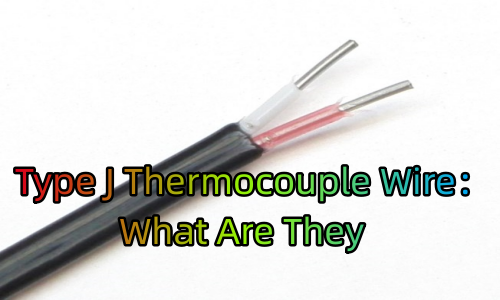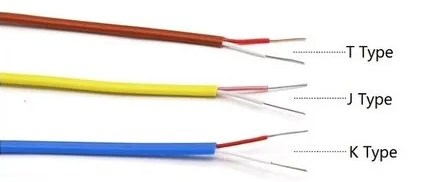OUTLINE:
What is Type J Thermocouple Wire
 164
164The world of temperature measurement can be intricate, but understanding the basics of thermocouple wire makes it a whole lot easier. In this guide, we'll delve into the specifics of Type J thermocouple wire, a widely used option for accurate and reliable temperature sensing.

Basic Definition of Thermocouples
Thermocouples are one of the most commonly used temperature sensing devices in industries. The working principle of thermocouples is based on the Seebeck effect, where two different conductor materials are connected to form a loop. When the temperatures at the two connection points differ, a physical phenomenon called thermoelectric current is generated within the loop.
Basic Principles of Temperature Measurement with Thermocouples
Thermocouples are temperature sensing elements that directly measure temperature and convert it into a thermoelectric potential signal. This signal is then converted into the temperature of the measured medium by electrical instruments. The working principle of thermocouples is based on the closed loop formed by two different conductor materials, whereby an electric current flows through the loop and generates a thermoelectric potential when a temperature gradient exists. This is known as the Seebeck effect. The two conductors of the thermocouple are referred to as the hot junction (at a higher temperature) and the cold junction (usually at a constant temperature).
What is Type J Thermocouple Wire
Imagine a flexible wire woven from two distinct metals – iron and constantan. That's the essence of J type thermocouple wire. When one end of this wire is exposed to heat, a tiny voltage develops due to the Seebeck effect. This voltage, directly proportional to the temperature difference between the hot and cold ends, serves as the basis for temperature measurement.
Type J Thermocouple Wire Specifications
Type J thermocouple wire is composed of two different metal alloys: Iron (positive leg) and Constantan (negative leg). It is known for its temperature range and compatibility with various environments.
Temperature Range: -40°C to 750°C (-40°F to 1382°F)
Sensitivity: Approximately 52 µV/°C (30 µV/°F)
Accuracy: Typically ±0.75°C (±1.35°F)
Cost: Economical compared to other thermocouple types
Applications: Widely used in industrial ovens, furnaces, kilns, boilers, scientific experiments, food processing, and various other temperature monitoring applications.

What Wires Are Used in Thermocouples
Thermocouples utilize different wire combinations based on their thermocouple types. Besides Type J, commonly used thermocouple wires include:
Type K: Comprising Chromel (positive leg) and Alumel (negative leg), Type K thermocouple wire is widely used in various industries due to its broad temperature range and compatibility.
Type T: Type T thermocouple wire consists of Copper (positive leg) and Constantan (negative leg). It is suitable for low-temperature applications and has excellent accuracy.
Type E: Type E thermocouple wire is composed of Chromel (positive leg) and Constantan (negative leg). It offers high accuracy and is commonly used in cryogenic and low-temperature applications.

Type J thermocouples Wire Applications
Type J wires are everywhere! They monitor the fiery furnaces in steel mills, ensuring the metal melts at just the right temperature. They guard the delicate heat in incubators, nurturing precious lives. They even keep an eye on the sizzling grills in burger joints, ensuring your patty reaches juicy perfection.
How Do We Connect a J type Thermocouple Wire
Prepare the wires: Strip the insulation from the ends of the thermocouple wires, exposing approximately 1/4 inch of bare wire.
Twist the wires: Twist the positive (Iron) and negative (Constantan) wires together tightly. This ensures a solid electrical connection.
Secure the connection: Use thermocouple connectors or ceramic insulators to secure and insulate the twisted wire connection. This helps maintain accurate temperature measurements and prevents electrical interference.
Verify the connection: Use a multimeter or thermocouple reader to check the continuity and proper functioning of the thermocouple wire.
Beyond the Basics
While Type J wires are versatile enough for most everyday mysteries, let's delve deeper into their toolbox:
Insulation Options: From PVC to Teflon, different insulation materials protect the wires from extreme temperatures, chemicals, and abrasion, tailoring them to specific environments.
Connector Types: Bayonet, mini-con, spade – these are just a few of the disguises your detective can wear to seamlessly integrate into various equipment.
The End
Type J thermocouple wire offers a versatile and affordable solution for accurate temperature measurement across a wide range. Its easy connection, robust construction, and relatively large operating temperature range make it a popular choice for various industrial and scientific applications.

Disclaimer: The views and opinions expressed by individual authors or forum participants on this website do not represent the views and opinions of Chipsmall, nor do they represent Chipsmall's official policy.

share this blog to:

